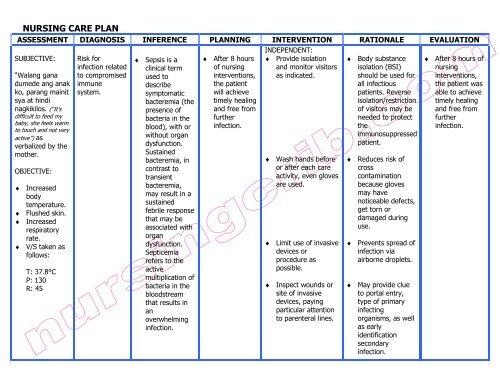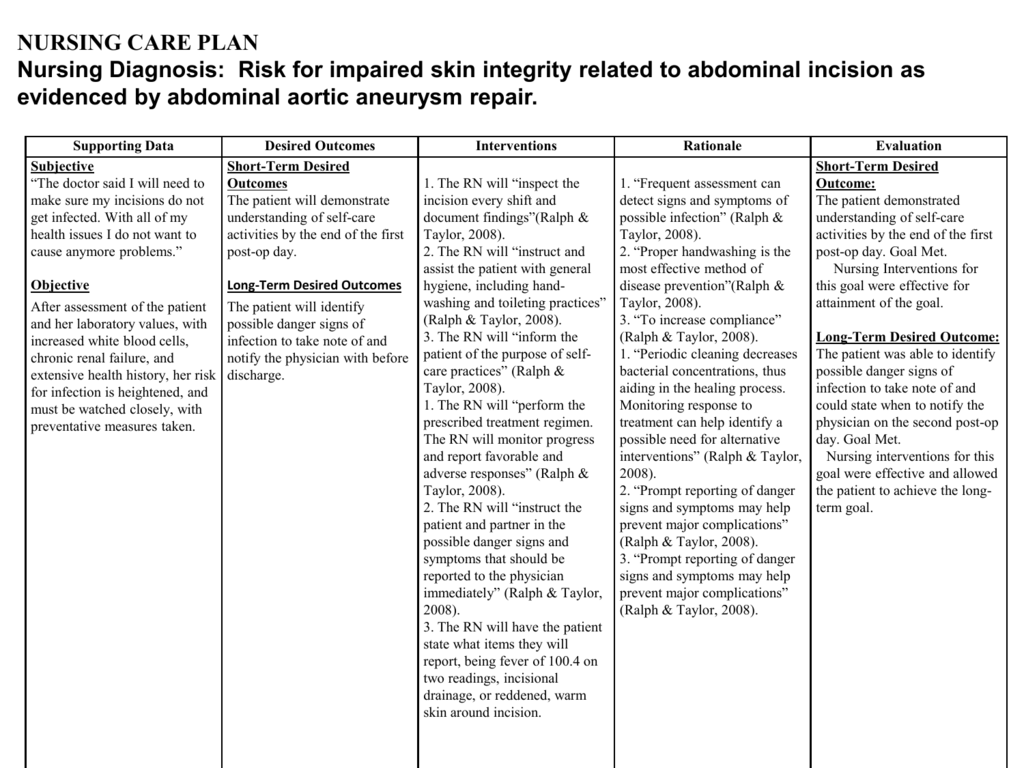Care plan risk for infection 2 1d472gx13mn2. Monitor temperature at least every 8 hours and notify physician if greater than 100 8 f.
 Nursing Care Plan Cord Care Doc Assessment Subjective Cues Mother Nursing Diagnosis Risk For Infection Related To Inadequate Primary Defenses Broken Course Hero
Nursing Care Plan Cord Care Doc Assessment Subjective Cues Mother Nursing Diagnosis Risk For Infection Related To Inadequate Primary Defenses Broken Course Hero
To reduce the number of organisms in patient s environment and restrict visitation by individuals with any type of infection to reduce the transmission of pathogens to the patient.

Care plan for risk of infection. Risk for infection care plan human immune system is made up of a variety of cells that are designed to protect the body from different pathogens such as bacteria viruses fungi etc. The risk for infection care plan interventions and rationale the success of a risk for infection care plan is dependent on the kind of interventions a caregiver will make. These infections can be caused by viruses bacteria fungi and other microorganisms.
Help patient change positions frequently. Evaluate sputum characteristics for frequency purulence blood and odor. Washing between procedures reduces the risk of transmitting pathogens from one area of the body to another e g perineal care or central line care.
Identify participate in behaviors to reduce risk of infection. Download view care plan risk for infection 2 as pdf for free. Encourage coughing and deep breathing exercises.
Helps reduce the stasis of secretions in the lungs and bronchial tree. When a pathogen enters a human body it will face the barrier of skin epidermal layer and mucus membrane as the first protection. Risk for infection is one of the common problems of an individual wherein there is an alteration or disturbance in the immune defenses which causes microorganisms to enter and invade the body which later one causes different kinds of infections.
Patients who have undergone treatment for cancer or currently have an untreated cancer can develop who is called neutropenia. Introduce the patient to food rich in protein and calories. Wash hands before and after all care contacts.
This ultimately reduces the risk for bladder infection or urinary tract infection. Administer antibiotics as prescribed to treat current infection and to avoid any other possible infections. These microbes will invade and attack the body and thereby.
The following are nursing interventions that help in reducing the risk of infection. Evaluate risk for infection after any instrumentation of the respiratory tract for at least 48 hours after procedure. It prevents stasis of secretions and pathogens in the lungs and bronchial tree.
A balanced intake of omega 3 and omega 6 fatty acids protein vitamins a c and e zinc and iron is essential in reducing the risk of infection. Assess patient knowledge and ability to maintain opportunistic infection prophylactic regimen. Encourage patient to eat a balanced diet.
This nursing care plan risk for infection includes a diagnosis and care plan for nurses with nursing interventions and outcomes for the following conditions.
 Nursing Care Plan And Diagnosis For Risk For Infection Related To Cancer Neutropenia Nanda Nursing Interventions And Outcomes Goals
Nursing Care Plan And Diagnosis For Risk For Infection Related To Cancer Neutropenia Nanda Nursing Interventions And Outcomes Goals
 Nursing Care Plan Sepsis Pdf Nursing Crib
Nursing Care Plan Sepsis Pdf Nursing Crib

 Nursing Diagnosis Format Pictures Wallpapers Nursing Diagnosis Nursing Care Plan Pediatric Nursing
Nursing Diagnosis Format Pictures Wallpapers Nursing Diagnosis Nursing Care Plan Pediatric Nursing


 Nursing Care Plan Nursing Diagnosis Risk For Impaired Skin
Nursing Care Plan Nursing Diagnosis Risk For Impaired Skin
 Ncp Risk For Infection Nursing Care Plan Nursing Care Care Plans
Ncp Risk For Infection Nursing Care Plan Nursing Care Care Plans
 Nursing Care Plan For Lower Extremity Infections In People With Diabetes Download Scientific Diagram
Nursing Care Plan For Lower Extremity Infections In People With Diabetes Download Scientific Diagram
 Ob Care Plan Risk For Infection Studocu
Ob Care Plan Risk For Infection Studocu

 Ncp Risk For Infection Related To Postop Incision Nursing Care Plan Nursing Care How To Plan
Ncp Risk For Infection Related To Postop Incision Nursing Care Plan Nursing Care How To Plan
 Risk For Infection Care Plan And Nursing Diagnosis Nurseslabs
Risk For Infection Care Plan And Nursing Diagnosis Nurseslabs
